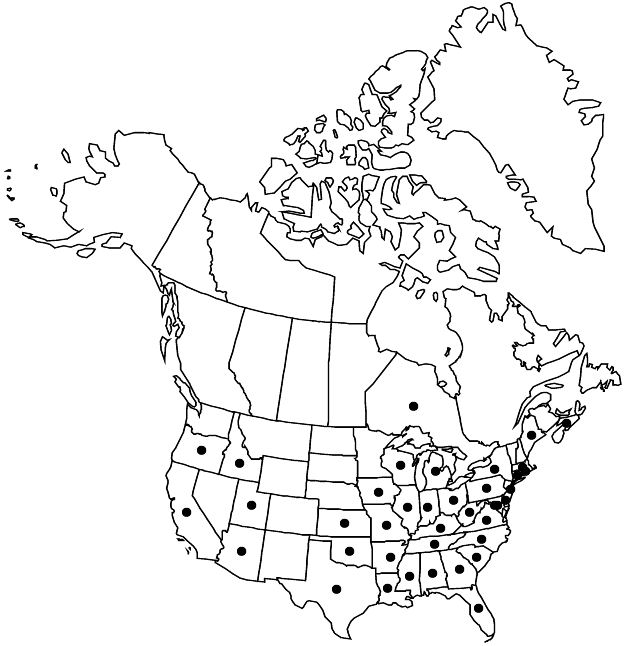Difference between revisions of "Prunus persica"
Beytr. Entw. Gewächsreich, 30. 1801.
FNA>Volume Importer |
imported>Volume Importer |
||
| (One intermediate revision by the same user not shown) | |||
| Line 38: | Line 38: | ||
|elevation=0–2300 m | |elevation=0–2300 m | ||
|distribution=N.S.;Ont.;Ala.;Ariz.;Ark.;Calif.;Conn.;Del.;D.C.;Fla.;Ga.;Idaho;Ill.;Ind.;Iowa;Kans.;Ky.;La.;Maine;Md.;Mass.;Mich.;Miss.;Mo.;N.J.;N.Y.;N.C.;Ohio;Okla.;Oreg.;Pa.;R.I.;S.C.;Tenn.;Tex.;Utah;Va.;W.Va.;Wis.;e Asia. | |distribution=N.S.;Ont.;Ala.;Ariz.;Ark.;Calif.;Conn.;Del.;D.C.;Fla.;Ga.;Idaho;Ill.;Ind.;Iowa;Kans.;Ky.;La.;Maine;Md.;Mass.;Mich.;Miss.;Mo.;N.J.;N.Y.;N.C.;Ohio;Okla.;Oreg.;Pa.;R.I.;S.C.;Tenn.;Tex.;Utah;Va.;W.Va.;Wis.;e Asia. | ||
| + | |introduced=true | ||
|discussion=<p>Peaches are cultivated throughout much of North America. Commercial production is diffuse, occurring in over half of the lower 48 states as well as in southern British Columbia and southern Ontario. Freestone peaches for fresh eating come largely from California, Georgia, New Jersey, North Carolina, Pennsylvania, and South Carolina; most clingstones are used for canning and are grown in California. Nectarines are a variety with hairless skin. The fruits are popular on picnics, and peach saplings are commonly encountered anywhere pits are discarded. Escapes are usually short-lived; some escapes form naturalized populations. Double-flowered cultivars are used ornamentally.</p> | |discussion=<p>Peaches are cultivated throughout much of North America. Commercial production is diffuse, occurring in over half of the lower 48 states as well as in southern British Columbia and southern Ontario. Freestone peaches for fresh eating come largely from California, Georgia, New Jersey, North Carolina, Pennsylvania, and South Carolina; most clingstones are used for canning and are grown in California. Nectarines are a variety with hairless skin. The fruits are popular on picnics, and peach saplings are commonly encountered anywhere pits are discarded. Escapes are usually short-lived; some escapes form naturalized populations. Double-flowered cultivars are used ornamentally.</p> | ||
|tables= | |tables= | ||
| Line 62: | Line 63: | ||
|publication year=1801 | |publication year=1801 | ||
|special status=Introduced | |special status=Introduced | ||
| − | |source xml=https:// | + | |source xml=https://bitbucket.org/aafc-mbb/fna-data-curation/src/2e0870ddd59836b60bcf96646a41e87ea5a5943a/coarse_grained_fna_xml/V9/V9_611.xml |
|subfamily=Rosaceae subfam. Amygdaloideae | |subfamily=Rosaceae subfam. Amygdaloideae | ||
|tribe=Rosaceae tribe Amygdaleae | |tribe=Rosaceae tribe Amygdaleae | ||
Latest revision as of 22:58, 5 November 2020
Trees, not suckering, 30–100 dm, not thorny. Twigs with terminal end buds, glabrous. Leaves deciduous; petiole 5–10(–15) mm, not winged, glabrous, sometimes glandular distally, glands 1–4, discoid; blade oblong to lanceolate, folded along midribs, often falcate, (5–)7–15 × 2–4.5 cm, base cuneate to obtuse, margins crenulate-serrulate, teeth blunt, glandular, apex acuminate, surfaces glabrous. Inflorescences usually solitary flowers, sometimes 2-flowered fascicles. Pedicels 0–3 mm, glabrous. Flowers blooming before leaf emergence; hypanthium cupulate, 4–5 mm, glabrous externally; sepals spreading, oblong-ovate, 3.5–5 mm, margins entire, ciliate, abaxial surface hairy (especially along margins), adaxial glabrous; petals dark pink, obovate to suborbiculate, 10–17 mm; ovaries hairy. Drupes yellow to orange tinged with red, globose, 40–80 mm, velutinous (glabrous in nectarines); mesocarps fleshy; stones ellipsoid, strongly flattened, deeply pitted, furrowed. 2n = 16.
Phenology: Flowering Feb–Apr; fruiting Jun–Aug.
Habitat: Roadsides, fencerows, abandoned farms, streamsides, canyons
Elevation: 0–2300 m
Distribution

Introduced; N.S., Ont., Ala., Ariz., Ark., Calif., Conn., Del., D.C., Fla., Ga., Idaho, Ill., Ind., Iowa, Kans., Ky., La., Maine, Md., Mass., Mich., Miss., Mo., N.J., N.Y., N.C., Ohio, Okla., Oreg., Pa., R.I., S.C., Tenn., Tex., Utah, Va., W.Va., Wis., e Asia.
Discussion
Peaches are cultivated throughout much of North America. Commercial production is diffuse, occurring in over half of the lower 48 states as well as in southern British Columbia and southern Ontario. Freestone peaches for fresh eating come largely from California, Georgia, New Jersey, North Carolina, Pennsylvania, and South Carolina; most clingstones are used for canning and are grown in California. Nectarines are a variety with hairless skin. The fruits are popular on picnics, and peach saplings are commonly encountered anywhere pits are discarded. Escapes are usually short-lived; some escapes form naturalized populations. Double-flowered cultivars are used ornamentally.
Selected References
None.